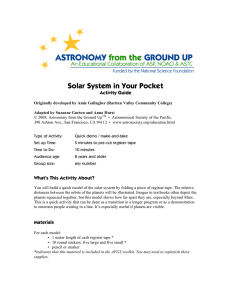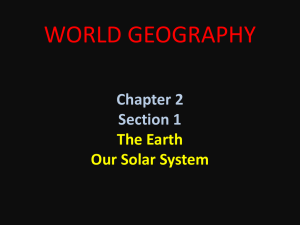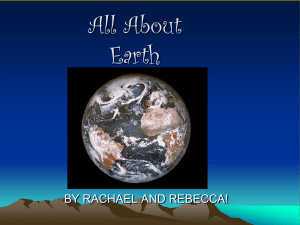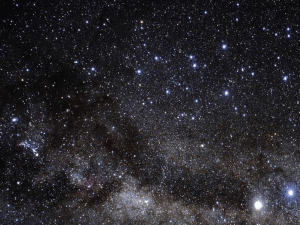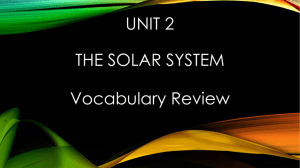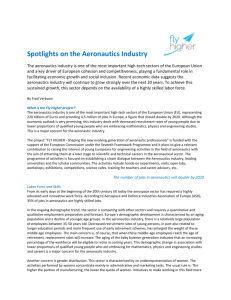Pocket Solar System
advertisement
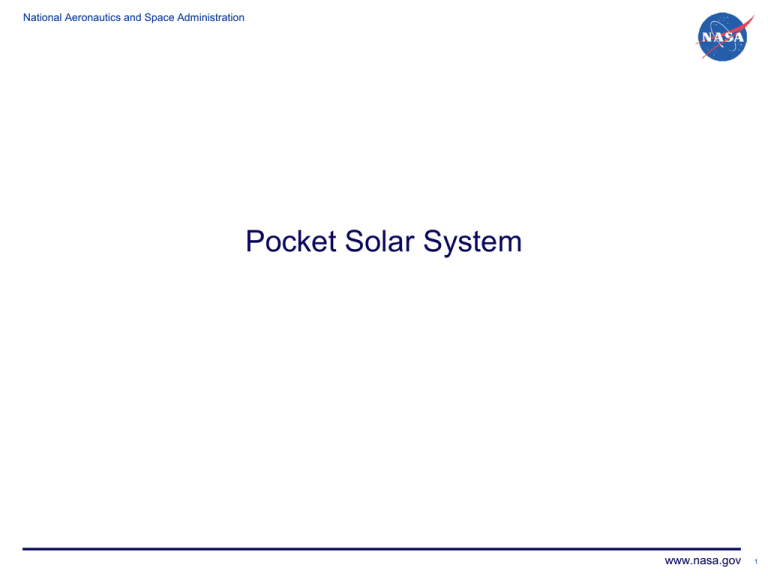
National Aeronautics and Space Administration Pocket Solar System www.nasa.gov 1 National Aeronautics and Space Administration Just to review, the order of the planets and large objects going out from the Sun and their average distances are: Object Distance in Kilometers Distance in AU Mercury 58 million 0.39 Venus 108 million 0.72 Earth 150 million 1 Mars 228 million 1.52 Asteroid Belt 416 million 2.77 Jupiter 778 million 5.2 Saturn 1,427 million 9.54 Uranus 2,870 million 19.2 Neptune 4,497 million 30.1 Pluto and the inner edge of the Kuiper belt 5,850 milllion 39.5 Eris 10,200 million 67.8 AU stands for Astronomical Unit and is defined as the average distance between the Sun and Earth. www.nasa.gov 2 National Aeronautics and Space Administration Making Our Pocket Solar System Step 1: Fold over the ends of your register tape so they are straight. Label one end “Sun” and the other end “Pluto/Kuiper Belt” Step 2: Fold the tape in half, crease it open it up again, and place a mark at the half-way point. Which plant does this mark represent? www.nasa.gov 3 National Aeronautics and Space Administration Making Our Pocket Solar System Step 3: Now fold the tape back in half, then half again. Unfold and lay it flat. Now you have the tape divided in quarters with the Sun at one end, Pluto on the other and Uranus in the middle. Place a mark at the quarter and ¾ mark. Which planets are represented by each of these marks? Reflection: Which part of the solar system has filled ¾ of your register tape? How many planets do we still need to represent? www.nasa.gov 4 National Aeronautics and Space Administration Making Our Pocket Solar System Step 4: Fold the Sun up to Saturn and crease it. Unfold and lay flat again. Place a mark at the 1/8 mark (between the Sun and Saturn. Which planet is represented by this mark? Reflection: If you take a look, you have the 4 gas giants and Pluto all on there. For the remaining bodies in the Solar System, you will only need ½ of the first 1/8th of the register paper (ie. that’s the inner 1/16th of the paper!) www.nasa.gov 5 National Aeronautics and Space Administration Making Our Pocket Solar System Step 5: Fold the Sun out to meet Jupiter to mark the 1/16th spot. A planet does not go here, but the Asteroid Belt does. Step 6: Fold the Sun to the Asteroid Belt mark and crease it. Place a mark on this fold (between the Sun and Asteroid Belt). Which planet is represented by this mark? www.nasa.gov 6 National Aeronautics and Space Administration Making Our Pocket Solar System Reflection: How many more planets do we need to place? Step 7: Fold the Sun up to meet the line for Mars. Leave it folded and fold that section in half. Unfold the tape and you should have three creases. Mark the remaining planets (in proper order) at each of the creases. Pluto Neptune Uranus Saturn Jupiter A.B Inner Planets Sun www.nasa.gov 7 National Aeronautics and Space Administration Making Our Pocket Solar System Reflection Questions: 1. Are there any surprises with your results? 2. Can you estimate where Eris will be using the same scale as your model? At its closest approach, it is 38 AU all the way out to 97 AU from the Sun at its farthest point. 3. If your model were 1 meter, where would the nearest star be? (1m=40 Aus, Proxima Centauri is 4.3 light years from the Sun, and 1 light year=65,000 Aus) 4. How big would the Sun and planets be if your model were one meter long? www.nasa.gov 8 National Aeronautics and Space Administration Making Our Pocket Solar System Reflection Question Answers: 1. Space is very empty in the outer Solar System. The inner Solar System is very crowded. 2. At 97 Aus, it would more than double the size of the model. You would need to add another one and a half meters to the model. 3. The nearest star would be about 7 kilometers or 4.2 miles away. 4. The Sun would be smaller than a grain of sand. You couldn’t see any of the planets without a magnifying glass on this scale! www.nasa.gov 9 National Aeronautics and Space Administration Sample 6-8th Grade TEKS Addressed By This Activity 6th Grade Earth and Space. The student understands the organization of our solar system and the relationships among the various bodies that comprise it. The student is expected to: Describe the physical properties, locations, and movements of the sun, planets, … 7th Grade Earth and Space. The student knows components of our solar system. The student is expected to: Analyze the characteristics of objects in our solar system that allow life to exist… 8th Grade Earth and Space. The student knows characteristics of the universe. The student is expected to: Describe components for the universe, including stars, nebulae, and galaxies… www.nasa.gov 10
